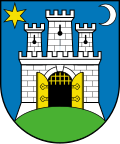Domestic
The slow or non-existent reaction from air defence services caused outrage among the Croatian media and public, [33] [34] with some comparing the incident to Mathias Rust's flight to the Red Square in 1987. [35]
President of Croatia Zoran Milanović described the crash as "a serious incident" and added that "in such situations you depend on NATO [...] while there was obviously some failure there". The President said Croatia knew where the drone flew from, "evidently Ukraine to Zagreb". [36] [37]
Prime Minister Plenković said on 12 March that "[t]his is a real threat. NATO and the EU were supposed to react. We will not tolerate such [a] situation [...] we were very lucky. This could have fallen on a nuclear power plant in Hungary." He also announced that he had written a letter to the Secretary General of NATO Jens Stoltenberg regarding the situation. [38]
The Mayor of Zagreb, Tomislav Tomašević, held a press conference regarding the incident and commented that "no people were hurt during the impact, but there is some property damage". [39] On 12 March 2022, Tomašević criticized certain unnamed foreign media sources for allegedly misrepresenting the location of the crash site. He stated: "I must admit that I am quite bothered by the information in foreign media sources, where I have read that such a large military aircraft had crashed in the suburbs of Zagreb, or that it had crashed next to Zagreb. No, it did not crash next to Zagreb, it crashed in the centre of Zagreb, in a densely populated area, and it did not crash in any type of suburban area." [40] [41] [42]
The Croatian online newspaper Index.hr suggested the drone may have been meant to fly to a location in Ukraine called Yarun' rather than the Zagreb neighborhood of Jarun, which sounds similar. [43] [44]
Distinguished Croatian Air Force pilot Ivan Selak criticized NATO's Combined Air Operations Centre in Torrejón, Spain, for not scrambling Romanian, Hungarian or Croatian Air Force jets to intercept the aircraft. [45]
On 12 March, the Croatian daily newspaper Jutarnji list wrote that Croatia might ask the United States to deploy their Patriot missile systems in the country. [46] Croatian military expert and former defence minister deputy Nikola Brzica commented, "Armed Forces of Croatia have at least two systems in their inventory, which could have brought down such a simple target, yet they weren't used. [...] It turns out that neither us [Croatians], nor Hungarians, nor Romanians properly tracked that target, nor contacted others and this is a big problem for NATO's air defence". [47]



